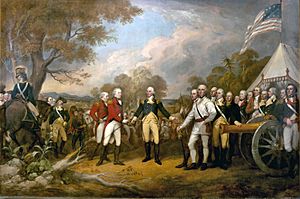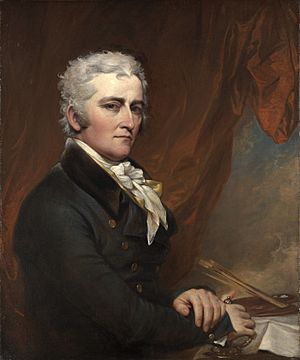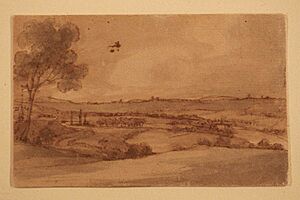Surrender of General Burgoyne facts for kids
Quick facts for kids Surrender of General Burgoyne |
|
|---|---|
 |
|
| Artist | John Trumbull |
| Year | 1821 |
| Type | Oil painting |
| Dimensions | 3.7 m × 5.5 m (12 ft × 18 ft) |
| Location | United States Capitol rotunda, Washington, D. C. |
| Owner | United States |
The Surrender of General Burgoyne is a famous oil painting by John Trumbull. He finished it in 1821. Today, you can see it in the Rotunda of the United States Capitol building in Washington, D.C..
This painting shows an important moment from the American Revolutionary War. It depicts the surrender of British Lieutenant General John Burgoyne at Saratoga, New York. This event happened on October 17, 1777, just ten days after the Second Battle of Saratoga. The painting includes many important leaders from the American Continental Army and militia. It also shows the German commander Friedrich Adolf Riedesel and two British Army officers: General Burgoyne and General William Phillips.
Contents
About the Artist: John Trumbull
The artist, John Trumbull (1756–1843), was a soldier himself during the early part of the American Revolutionary War. He worked as an assistant to important generals like George Washington and Horatio Gates. In 1777, he left the army to become an artist.
By 1785, Trumbull started planning a series of large paintings. He wanted these paintings to remember the most important events of the American Revolution. In 1791, he even traveled to Saratoga, New York, to sketch the actual place where the surrender happened. This helped him make his painting accurate.
Creating the Capitol Paintings
After the War of 1812 ended, Trumbull returned from Britain. He suggested his idea for the paintings to the United States Congress. Congress was impressed by his other works, like The Death of General Warren at the Battle of Bunker's Hill, June 17, 1775 and The Death of General Montgomery in the Attack on Quebec, December 31, 1775.
In 1817, Congress decided to hire Trumbull to create four large paintings. These paintings would hang in the United States Capitol rotunda. Each painting cost $8,000. President James Madison helped decide the size and what each painting would show.
They agreed on a size of twelve by eighteen feet (about 3.7 meters by 5.5 meters). The four chosen subjects were:
- The Declaration of Independence
- The Surrender of General Burgoyne
- The Surrender of Lord Cornwallis
- General George Washington Resigning His Commission
Trumbull spent the next eight years working on these paintings. He finished the Surrender of General Burgoyne in late 1821. It was first shown in New York City from January to March 1822. Trumbull himself oversaw its hanging in the Capitol rotunda in 1824. It has been there ever since.
What the Painting Shows
This painting shows General John Burgoyne getting ready to give his sword to General Horatio Gates. This act symbolized his surrender. American officers stand on the sides, watching this important event. Their different uniforms show they came from various military groups.
In the middle and background of the painting, you can see Burgoyne's army. This includes his German soldiers. American Colonel Lewis, who was the Quartermaster-General, is shown on horseback in the distance, guiding them to the camp.
The scene looks peaceful, not like a battle. The sky is blue with white clouds. The officers are wearing their best uniforms. Weapons are put away, and cannons are quiet. This shows the end of the fighting and the beginning of peace.
Other Versions of the Painting
John Trumbull also made a smaller version of this painting. It looks very similar to the one in the Capitol. This smaller painting is now kept at the Yale University Art Gallery. The large painting in the Capitol rotunda was even used on a special postage stamp in 1994 to remember the event.
Images for kids






